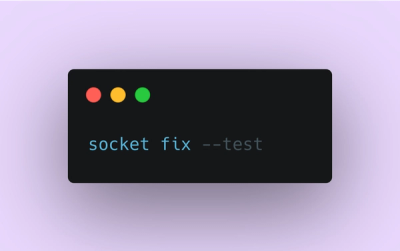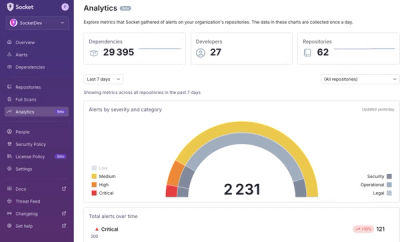
Product
Introducing Socket Fix for Safe, Automated Dependency Upgrades
Automatically fix and test dependency updates with socket fix—a new CLI tool that turns CVE alerts into safe, automated upgrades.
Nexmon CSI utilities for Raspberry Pi
In development • Not ready for testing yet.
picsi up or picsi downpicsi disableOn a Raspberry Pi 3B+ or 4B, run:
sudo apt install python3-pip # install pip for python3
pip3 install picsi # install picsi
source ~/.profile # update $PATH
picsi install # install nexmon_csi
picsi will download the appropriate firmware and binaries for
your system and install them, or compile from source if they
are not available pre-compiled.
picsi enable # enable nexmon_csi
picsi up # Collect CSI on 36/80
This enables Nexmon_csi, and starts CSI collection on channel 36 with
bandwidth 80 MHz. You can see the traffic with tcpdump -i wlan0 dst port 5500.
More examples:
picsi up 149/80 # Collect CSI on 149/80
picsi down # Stop CSI collection
picsi disable # Restore original WiFi
picsi status # See status
picsi --help # See the help page
Picsi (pronounced pixie?) is a Python tool to install Nexmon CSI on Raspberry Pis.
It needs Python version >= 3.7, although using the latest version is recommended.
The best features of picsi, in my opinion, are:
Compiling Nexmon_CSI on the Pi takes about an hour, and downloads about 1.5 GB of data. And it needs your attention for the entire duration because you need to reboot the Pi multiple times, and keep a look out for errors.
Picsi downloads appropriate pre-compiled nexmon_csi firmware and binaries (nexutil, makecsiparams) for your kernel from https://github.com/nexmonster/nexcsi-bin.git (repository not available yet), and installs them. If binaries are not available, it installs from source, including automatic unattended reboots, and logs errors and progress.
Picsi can forward CSI packets to a different computer on your network, which is potentially faster than the Pi, and can collect more packets than tcpdump on the Pi can.
But additionally, an app on your phone/laptop can listen to the packets, and plot the CSI in realtime or process it.
Manage your csi collection configuration in profiles!
write
[profiles.CustomProfileName]
channel = 36
bandwidth = 80
coremask = 1
ssmask = 1
forward = false
forward_ip = '192.168.1.25'
duration = 30
macids = ['ab:cd:ef:12:34']
in profiles.toml, and you can start csi collection with
picsi up CustomProfileName.
This collects CSI on channel 36, bandwidth 80 from macids for 30 seconds, and forwards that CSI to 192.168.1.25. After 30 seconds, CSI collection is stopped and original wifi firmware is restored.
You can also create a set of profiles, and make picsi loop CSI collection over them.
Only basic CSI collection via profiles will be added first, and other profile features will be added later.
FAQs
CSI collection on Raspberry Pi
We found that picsi demonstrated a healthy version release cadence and project activity because the last version was released less than a year ago. It has 1 open source maintainer collaborating on the project.
Did you know?

Socket for GitHub automatically highlights issues in each pull request and monitors the health of all your open source dependencies. Discover the contents of your packages and block harmful activity before you install or update your dependencies.

Product
Automatically fix and test dependency updates with socket fix—a new CLI tool that turns CVE alerts into safe, automated upgrades.

Security News
CISA denies CVE funding issues amid backlash over a new CVE foundation formed by board members, raising concerns about transparency and program governance.

Product
We’re excited to announce a powerful new capability in Socket: historical data and enhanced analytics.